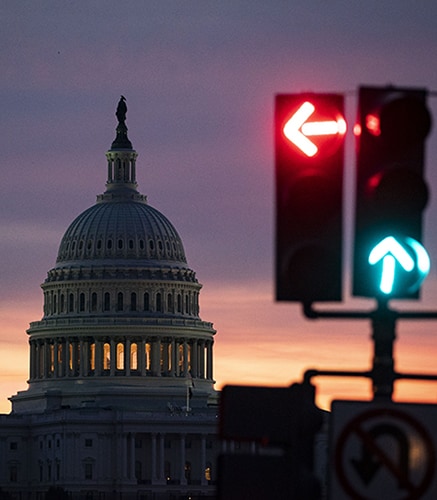Tax News You Can Use | For Professional Advisors
Jane Ditelberg, Director of Tax Planning
Sara M. Veith, Senior Wealth Advisor
November 17, 2025
At an all-time high in 2025, the gift tax annual exclusion is one of the most well-known and effective ways to reduce the size of an estate for estate tax purposes, as gifts that qualify are not subject to federal gift tax and do not use any of one's lifetime exclusion amount.
In 2025, the annual exclusion allows an unmarried taxpayer to make gifts of up to $19,000 per year to anyone, while married taxpayers can make gifts of up to $38,000 (twice the amount) per individual if their spouse agrees to sign an election treating it as made one half by each of them. As an example, if a taxpayer's estate exceeds the current basic exclusion amount of $13.99 million, each annual exclusion gift made during their lifetime can save $7,600 in estate tax. If this is done every year for multiple recipients, the tax savings rapidly add up.
Naturally, many donors prefer such gifts go to children or grandchildren. Making gifts to minors can present complexities, however. Gifts to minors must be structured so that either an adult or a corporate fiduciary holds the assets for the beneficiary until they come of age. If the donor prefers to make the gift in trust, the transfer must be to one of three specific types of trusts for the gift to qualify for the annual exclusion. 2025 tax legislation also introduced the Trump Account for 2026 — essentially an IRA for minors that is another way to make gifts to minors safely.
How Do I Make A Gift To My Children Or Grandchildren Who Are Under The Age Of 18?
There are a variety of mechanisms a donor can use to make a gift to a minor, each of which has pros and cons. When deciding which vehicles to use, donors and their advisors should consider:
- The income, gift and GST tax consequences
- At what age the beneficiary can access funds
- Goals for use of the funds
- Whether an annual income tax return must be filed
- Level of complexity
It is important to be intentional about your goals for the transfer. For example, if the funds are intended for education, then a 529 plan, the direct payment of tuition or a Trump Account might make the most sense. However, neither a 529 plan nor the direct payment of tuition is appropriate if the purpose of the gift is to enable the beneficiary to purchase a home or save for retirement. Unless otherwise noted, gifts within the annual exclusion limits ($19,000/$38,000)1 can be made using the techniques discussed without GST tax consequences, even if one or more beneficiaries is more than one generation younger than the donor.
- The simplest way to make gifts is to pay expenses on the beneficiary's behalf. As a bonus, if the payment is a medical expense or tuition paid directly to the provider, it is not considered a gift for tax purposes, the $19,000 limit does not apply, and the transfer does not use the annual exclusion. Direct payment of other expenses on a beneficiary's behalf, such as the costs of extracurricular activities, travel expenses or childcare, however, are considered gifts, but the annual exclusion can be applied.
- A donor may create a custodianship under the Uniform Transfers to Minors Act (UTMA) or its predecessor, the Uniform Gifts to Minors Act (UGMA), simply by registering assets in the name of an adult or a financial institution as custodian under the UTMA of a particular state for the benefit of a particular minor. This approach does not require a separate tax return or the preparation of a formal annual trust accounting and is generally less complicated than using trusts. However, the assets must be distributed to the beneficiary when they reach their state's age of majority. The age of majority varies among states but can be as low as 18 or as high as 25. The income is reported under the minor beneficiary's tax identification number and taxed according to the Kiddie Tax rules on the parents' return.
- Contributing to a state-sponsored 529 college savings account is a technique for funding higher education that, additionally, offers the unique opportunity to front-load the gift with five years' worth of annual exclusion gifts. There is also the possibility of income-tax-free growth on the assets in the account as long as they are used for an approved purpose. Note that some states offer a possible income tax deduction for state tax purposes on contributions to 529 plans; the downside is that 529 accounts can generally only be used for education unless taxes and penalties are paid. OBBBA further expanded the flexibility of 529 plans. Starting in 2026, the annual withdrawal limit for K–12 education expenses doubles from $10,000 to $20,000 per beneficiary, and the definition of qualified expenses now includes curriculum materials, tutoring, online education, standardized test fees, dual-enrollment tuition and educational therapies for students with disabilities. 529 funds can also be used for job training, professional licensing, and continuing education. Rollovers to ABLE accounts are now permanent, and the 529-to-Roth IRA rollover provision remains in effect. Note that not all states have to date conformed their plans or their tax laws to provide benefits similar to the new federal rules.
- Trump Accounts, established under OBBBA, are tax-deferred savings vehicles for minors that are treated similarly to traditional IRA accounts. Beginning July 5, 2026, up to $5,000 (adjusted for inflation starting in 2027) can be contributed to a minor’s Trump Account. Employers may contribute up to $2,500 per year, which counts toward the $5,000 limit. For children born between January 1, 2025, and December 31, 2028, there is a one-time $1,000 federal government seed deposit, which does not count toward the annual limit. Investments are limited to low-cost index funds tracking U.S. equity markets until the beneficiary reaches age 18. Upon the minor reaching age 18, the account must be converted to an IRA, at which point the IRA withdrawal rules will apply. Funds can be used for education, a first home, starting a business, or retirement.
- The IRS recognizes that there should be a way to make a gift in trust to a minor that satisfies the present interest requirement to qualify for the annual exclusion. Their solution is the section 2503(c) minor’s trust. This is a trust requiring a trustee, annual income tax returns, separate investments and an annual accounting. The primary drawback, besides the complexity, is that it is required to terminate at age 21, at which point it cannot be used for further gifts. In some instances, the beneficiary has a right of withdrawal at 21, and the assets can remain in the trust longer than that, but future contributions will not qualify for annual exclusion treatment.
- Another type of qualifying trust is one that includes Crummey powers. Named after a famous tax case, this is a trust where the beneficiary has the power to withdraw assets contributed to the trust for a period of at least 30 days after every contribution. While it is considerably more complex than other options, it does provide a mechanism for the trust to continue receiving annual exclusion gifts after the beneficiary turns 21, as there is no age limit on this type of trust. This type of trust is treated as a separate taxpayer and files its own tax returns.
- A dynasty trust designed to benefit multiple beneficiaries, perhaps over several generations, can also be used for gifts to minors. A caveat is that the donor must use some of their GST tax exemption if they make gifts to a trust of this type because gifts to a trust for multiple beneficiaries do not qualify for the GST tax annual exclusion. The grantor can have the most say over what happens with this type of trust, but it is complex to administer and may be unwieldy for smaller gifts.
- If you attempt to make gifts directly to a minor without using a mechanism for adult control, the court will appoint a guardian of the estate/conservator (different terms are used in different states) to manage the funds, as they do when a minor receives an inheritance or is named as the beneficiary of life insurance or retirement benefits. This is the most complex, most expensive and most public way to administer assets for a minor, and is usually avoided when possible.
Techniques For Gifts To Minors
| Use of Funds | Child's Access | Gift Tax Considerations | Gsttax Considerations | Income Tax Considerations | Complexity | |
|---|---|---|---|---|---|---|
| Direct payment of tuition or health care expenses | Limited to tuition and health care | None | Not treated as a gift | Not treated as a gift | None | Lowest |
| Direct payment of other expenses | None | None | Gift tax annual exclusion applies | GST annual exclusion applies | None | Lowest |
| UTMA | Support | Outright at state's age of majority | Gift tax annual exclusion applies | GST annual exclusion applies | Income taxed to the minor, reported on parents' return | Low |
| 529 plan account | Education (K–12 up to $20,000/year, college, job training, test fees, curriculum, therapies, dual enrollment, ABLE rollovers, Roth IRA rollovers) | None - account owner (typically the donor) controls withdrawal | Gift tax annual exclusion applies. Can front-load five years' worth of annual exclusion gifts | GST annual exclusion applies. Can front-load five years' worth of annual exclusion gifts | No income tax if used for permitted educational purposes | Low |
| Trump Account | Education, home, business, retirement | At age 18, IRA distribution rules apply, including possible early distribution penalties for distributions before age 59.5 | Annual exclusion applies(2) (up to $5,000/year + $1,000 seed deposit for eligible children) | GST exemption must be allocated for skip persons | Earnings taxed as ordinary income when withdrawn; contributions not taxed | Low |
| Minor's trust | Any | Must have right of withdrawal at 21 | Qualifies for gift tax annual exclusion for gift prior to age 21, but not gifts made later | Qualifies for GST tax annual exclusion for gift prior to age 21 but not gifts made later | Separate taxpayer, trust pays tax | Moderate |
| Crummey powers trust | Any | Per terms of trust decided by donor, although beneficiary has limited power of withdrawal every year | Qualifies for the gift tax annual exclusion | Can qualify for the GST annual exclusion if only one beneficiary with a general power of appointment | A separate taxpayer, but might be taxed to grantor or beneficiary depending on terms of the trust | Highly complex |
| Dynasty trust for multiple generations of family members | Any | Per the terms of the trust | Not usually, although possible to include Crummey powers rights of withdrawal to qualify some gifts for exclusion | No. GST exemption must be allocated to the trust if there are beneficiaries who are grandchildren or more remote descendants | A separate taxpayer, but might be taxed to the grantor depending on the terms of the trust | Highly complex |
| Guardianship/ conservatorship | Court approval is needed to expend the funds | Funds are released to the beneficiary at the state's age of majority, typically 18 | Qualifies for the gift tax annual exclusion | Qualifies for the GST annual exclusion | Taxed to the beneficiary, reported on beneficiary's or parents' return | Most complex |



